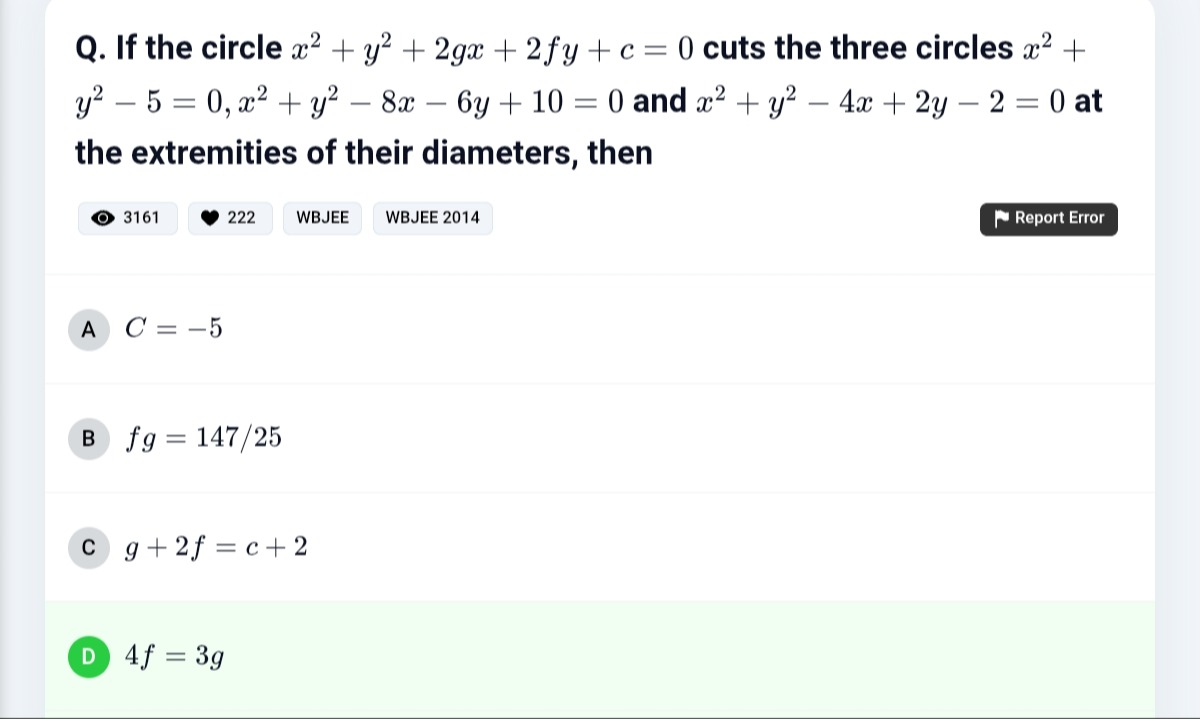Question
Question: If the circle $x^2 + y^2 + 2gx + 2fy + c = 0$ cuts the three circles $x^2 + y^2 - 5 = 0, x^2 + y^2 -...
If the circle x2+y2+2gx+2fy+c=0 cuts the three circles x2+y2−5=0,x2+y2−8x−6y+10=0 and x2+y2−4x+2y−2=0 at the extremities of their diameters, then

C=−5
fg=147/25
g+2f=c+2
4f=3g
A, B, D
Solution
The problem states that a circle S:x2+y2+2gx+2fy+c=0 cuts three other circles S1,S2,S3 at the extremities of their diameters.
Understanding the condition:
If a circle S cuts another circle Si at the extremities of its diameter, it means that the common chord of S and Si is a diameter of Si. This implies that the center of Si must lie on the common chord of S and Si.
Let the equation of circle S be x2+y2+2gx+2fy+c=0.
Let the equation of circle Si be x2+y2+2gix+2fiy+ci=0.
The equation of the common chord of S and Si is S−Si=0, which simplifies to:
(2g−2gi)x+(2f−2fi)y+(c−ci)=0.
The center of circle Si is Ci(−gi,−fi).
For the common chord to be a diameter of Si, its center Ci must lie on the common chord. Substituting x=−gi and y=−fi into the common chord equation:
(2g−2gi)(−gi)+(2f−2fi)(−fi)+(c−ci)=0
−2ggi+2gi2−2ffi+2fi2+c−ci=0
Rearranging the terms, we get the condition:
2ggi+2ffi−c=2gi2+2fi2−ci.
Since Ri2=gi2+fi2−ci (where Ri is the radius of Si), the condition can also be written as:
2ggi+2ffi−c=2Ri2+ci.
Applying the condition to each circle:
-
For the circle S1:x2+y2−5=0
Here, g1=0,f1=0,c1=−5.
Radius squared R12=g12+f12−c1=02+02−(−5)=5.
Applying the condition 2gg1+2ff1−c=2R12+c1:
2g(0)+2f(0)−c=2(5)+(−5)
−c=10−5
−c=5⇒c=−5. -
For the circle S2:x2+y2−8x−6y+10=0
Here, g2=−4,f2=−3,c2=10.
Radius squared R22=g22+f22−c2=(−4)2+(−3)2−10=16+9−10=15.
Applying the condition 2gg2+2ff2−c=2R22+c2:
2g(−4)+2f(−3)−c=2(15)+10
−8g−6f−c=30+10
−8g−6f−c=40⇒8g+6f+c+40=0. -
For the circle S3:x2+y2−4x+2y−2=0
Here, g3=−2,f3=1,c3=−2.
Radius squared R32=g32+f32−c3=(−2)2+(1)2−(−2)=4+1+2=7.
Applying the condition 2gg3+2ff3−c=2R32+c3:
2g(−2)+2f(1)−c=2(7)+(−2)
−4g+2f−c=14−2
−4g+2f−c=12⇒4g−2f+c+12=0.
Solving the system of equations:
We have the following system of equations:
- c=−5
- 8g+6f+c+40=0
- 4g−2f+c+12=0
Substitute c=−5 into equations (2) and (3): 2. 8g+6f−5+40=0⇒8g+6f+35=0 3. 4g−2f−5+12=0⇒4g−2f+7=0
From equation (3), multiply by 3:
3(4g−2f+7)=0⇒12g−6f+21=0.
Add this to equation (2):
(8g+6f+35)+(12g−6f+21)=0
20g+56=0
20g=−56⇒g=−2056=−514.
Substitute g=−514 into 4g−2f+7=0:
4(−514)−2f+7=0
−556−2f+7=0
−2f=556−7
−2f=556−35
−2f=521⇒f=−1021.
So, the values are c=−5, g=−14/5, f=−21/10.
Checking the options:
A. C=−5: This matches our calculated value of c. So, A is correct.
B. fg=147/25:
fg=(−514)×(−1021)=5×1014×21=50294=25147. So, B is correct.
C. g+2f=c+2:
LHS: g+2f=−514+2(−1021)=−514−1042=−514−521=−535=−7.
RHS: c+2=−5+2=−3.
Since −7=−3, option C is incorrect.
D. 4f=3g:
LHS: 4f=4(−1021)=−1084=−542.
RHS: 3g=3(−514)=−542.
Since LHS = RHS, option D is correct.
Conclusion:
Options A, B, and D are correct.
